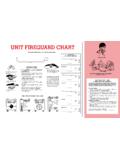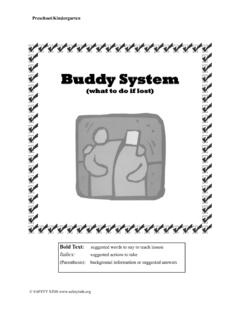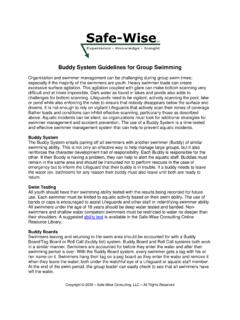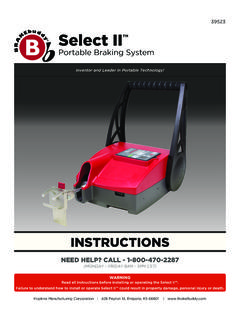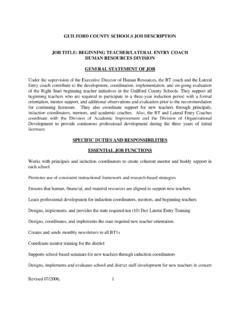Transcription of Trai ning Outline - BSA Troop 29
1 Tr a ining Outline1 SAFETY AFLOAT training OUTLINEI ntroductionSafety Afloat training is intended for use with Scouts and Scouters in a variety of situations. It should be offered to leaders at summer camp. training in Safety Afloat and BSA Paddle Craft Safety may be conducted jointly at summer camp. Those seeking only Safety Afloat training attend only the discussion section. Those seeking Paddle Craft Safety training also attend the skill training also can be conducted in connection with any Boy Scouts of America training program for Cub Scout, Boy Scout, Varsity Scout, or Venturing leaders. It should be included in the outdoor session of Scout -master ship Fundamentals, can be included in Boy Scout Leader Wood Badge, and can be offered in connection with other supplemental training is suggested that the training last about 50 minutes.
2 More time might be needed if the session includes a demonstration. The intended audience includes adult Scouters and junior may complete online training in Safe Swim Defense and Safety Afloat at MyScouting at complete and official statement of the Safety Afloat plan can be found in Aquatics Supervision No. 34346. Copies of Safety Afloat may be downloaded from the Guide to Safe Scouting, available online at ObjectivesAt the end of this session, each participant should be able to Understand and appreciate the most important and essential elements of aquatics safety supervision and discipline. Explain the distinct contribution of each of the nine points of the Safety Afloat program and how each helps assure safe unit activity afloat. Judge his or her readiness to conduct a safe activity afloat.
3 Identify resources for the skill training needed for activities Supervision: A leaders guide to swimming and boating activities, No. Afloat guide, No. 34368; one per participantSafety Afloat pocket card, No. 34242; one per participantLife Jackets for DemonstrationType II, No. 01596 Type III, No. 01592 Throwing DevicesType IV, buoyant cushion, No. 00154; ring buoy, No. 01138; throw bag2 Other Resources Safe Swim Defense, No. 34370 Fieldbook, No. 33104 Merit badge pamphlets: Canoeing, No. 33305B; Rowing, No. 33404; Small-Boat Sailing, No. 33356A; Whitewater, No. 33405B, and Motorboating, No. 33345 Annual Health and Medical Record, No. 34605 Local Tour Permit Application, No. 34426 Sample unit float plan, reproduced from page 6 Float trip buddy board ideas, actual items, or reproduced from page 7 Canoeing and boating guides and maps of local watersBoat or canoe equipped for demonstrationWho Can Instruct This training ?
4 This training can be given by any person authorized by the council, including a BSA Aquatics resource person, a unit leader with aquatics skill, or any other person with aquatic knowledge or experience that has been approved by the local council. The council may assign oversight of instructors to a local aquatics committee. Each instructor should review Safety Afloat material in Aquatics Supervision and complete online training in Safety Afloat prior to conducting the ProblemInvite the participants to relate their personal experiences with accidents or near-misses while afloat. Supplement their accounts with examples of actual incidents (news items, personal experiences, accident reports, etc.). Conclude the opening discussion with statistics reflecting Scouting s experience with boating and boating-related ResponseThe Safety Afloat program has been developed by the BSA to promote boating and boating safety and to set standards for safe unit activity PolicyExplain that before a BSA group may engage in any excursion, expedition, or trip on the water (canoe, raft, sailboat, sailboard, motorboat, rowboat, tube, or other watercraft), adult leaders for such activities should have an appreciation for the potential hazards they could encounter and should take steps to reduce those risks.
5 The nine points of Safety Afloat have been established by the Boy Scouts of America in an effort to reduce potential a copy of the Safety Afloat flier to each participant. Explain that each of the nine points will be reviewed in SwimDefenseDisplay a copy of the Safe Swim Defense leaflet. Explain that the Safety Afloat plan parallels the successful approach of the highly regarded Safe Swim Defense, which has given the BSA one of the best water-safety records of any youth that several Safety Afloat elements probably the most important also are found in the Safe Swim Defense: supervision, discipline, swimming ability, physical fitness, and the buddy DisciplineAsk the participants to note the first and last points of the plan qualified supervision and discipline.
6 These are the most important points of the plan because the effectiveness of the others depends upon these two. The fact that they are the first and last points of the list is symbolic, for they hold the plan first point recognizes that youth of Scouting age who are having fun with friends in or on the water are not likely to be concerned about their own health and safety. Even if concerned, usually they are not able to protect themselves fully. For this reason, qualified adult supervision is the first and most important element of Safety that when serious accidents happen in Scout aquatics, they usually involve a lack of supervision and discipline. If boating activity is not super-vised by a conscientious adult who has the attention and respect of the children in his or her care, accidents could occur.
7 Safety can be virtually assured if there is a caring adult who understands and appreciates the respon sibility for children in or around the water, and who has the control and respect of the children so that his or her directions will be Scout boating activity must be supervised by a mature and conscientious adult age 21 or older who understands and knowingly accepts his or her responsibility for the well-being and safety of the children in his or her care, is experienced in the water and confident of his or her ability to respond in the event of an emergency, and is trained in and committed to compliance with the nine points of BSA Safety Afloat. The importance of this supervision requirement, and the closely allied need for discipline, , control of the activity, cannot be overemphasized.
8 A responsible and conscientious supervisor knows his or her own limits, and will not put children at risk by permitting activity that could exceed his or her own ability to control and respond if an emergency does that for supervision to be effective, there must be discipline. All participants in an activity afloat should know, understand, and follow the safety rules and procedures. Discipline means that all do their part to ensure that the rules are fairly and impartially applied and followed. Involving Scouts in all of the details of planning a trip afloat is a good way to promote cooperation and and discuss points 1 and 9. Include situations where the unit leader can utilize the expertise of others, such as whitewater Health ReviewPoint out that when accidents do occur in aquatics, they frequently are caused by unknown physical conditions or the unexpected result of some known physical problem.
9 Activity afloat, like swimming, requires that the person in charge know the physical condition of all those for whom he or she is responsible. Good safety requires an understanding of the risks or hazards of any individual and discuss the text of point 2. Display and discuss the Annual Health and Medical Record. Parts A and C are required for all unit activities. Discuss activities for which the height-weight criteria apply. Part B is required for any event longer than 72 hours or more than 30 minutes away from ground transportation. Note that leader cardiac problems are the leading cause of death during Scouting out that the best protection on the water is the ability to swim. Review and discuss the text of point 3. The swimmer test demonstrates the minimum level of swimming ability required for safe deepwater swimming.
10 (Refer to Aquatics Supervision for guidelines on conducting swim classification tests.)Personal FlotationDevices (Life Jackets)Review and discuss the text of point 4. Display the types of life jackets gener-ally recommended for Scouting activities. Explain the features and uses of each. Point out that life jackets must be Coast Guard approved and that damaged PFDs are no longer approved. Demonstrate and explain how to fit and wear PFD Types II and III and how to use and throw Type IV. Emphasize that life jackets are effective only when worn, and that they should be worn at all times when aboard canoes, rafts, kayaks, and other small who goes in or on the water alone is foolish! Point out that there is a buddy system for activity afloat just as there is for swimming.
